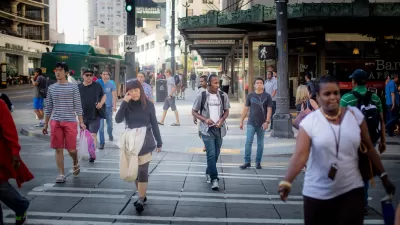New census data shows that millennials and seniors are migrating less, a result of the Great Recession and its economic impacts. For those who are moving, cities in the Sun Belt have been primary destinations.

Demographer William H. Frey writes about the migration trends of millennials and Baby Boomers after the Great Recession, evident in new American Community Survey data. Migration rates for both groups slowed during and after the recession, reflecting the job and housing challenges millennials have faced and the delayed retirement and relocation limitations of seniors, says Frey.
Migration magnets for millennials are largely Sun Belt cities in the South and West. Baby Boomers also have headed to the Sun Belt, but none of the top five cities for each group overlapped, notes Frey. While both groups are leaving high-cost metropolitan areas, particularly on the coasts, millennials are spreading out across the country while seniors are focusing on the more traditional retirement states of Arizona and Florida.
"Millennials are more mobile than their elders and more apt to shift with changing opportunities, particularly to areas with knowledge based economies. In contrast, those seniors who do move are zeroing in on a smaller set of exclusively Sun Belt destinations that have long been associated with retirees, warm climates and recreation," concludes Frey.
FULL STORY: How migration of millennials and seniors has shifted since the Great Recession

Alabama: Trump Terminates Settlements for Black Communities Harmed By Raw Sewage
Trump deemed the landmark civil rights agreement “illegal DEI and environmental justice policy.”

Planetizen Federal Action Tracker
A weekly monitor of how Trump’s orders and actions are impacting planners and planning in America.

Why Should We Subsidize Public Transportation?
Many public transit agencies face financial stress due to rising costs, declining fare revenue, and declining subsidies. Transit advocates must provide a strong business case for increasing public transit funding.

Understanding Road Diets
An explainer from Momentum highlights the advantages of reducing vehicle lanes in favor of more bike, transit, and pedestrian infrastructure.

New California Law Regulates Warehouse Pollution
A new law tightens building and emissions regulations for large distribution warehouses to mitigate air pollution and traffic in surrounding communities.

Phoenix Announces Opening Date for Light Rail Extension
The South Central extension will connect South Phoenix to downtown and other major hubs starting on June 7.
Urban Design for Planners 1: Software Tools
This six-course series explores essential urban design concepts using open source software and equips planners with the tools they need to participate fully in the urban design process.
Planning for Universal Design
Learn the tools for implementing Universal Design in planning regulations.
Caltrans
Smith Gee Studio
Institute for Housing and Urban Development Studies (IHS)
City of Grandview
Harvard GSD Executive Education
Toledo-Lucas County Plan Commissions
Salt Lake City
NYU Wagner Graduate School of Public Service




























